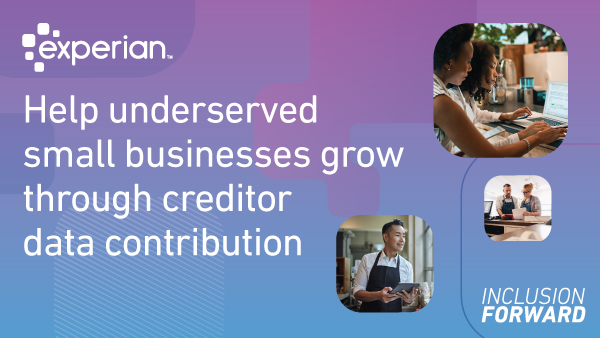Experian study of utility data reveals opportunity for unscored small businesses through early bureau data contribution.

In today’s business landscape, creditworthiness is critical to accessing the capital necessary for growth and success. However, many businesses, particularly small businesses, struggle to establish and maintain a strong credit profile. These businesses may be profitable, but to the credit system, until enough of their trading partners report payment experiences to the credit bureaus, they fall into a “Credit Invisible” segment. Experian Commercial Decision Sciences recently conducted a study of a regional utility company’s portfolio, revealing a significant number of credit-invisible small businesses that had been doing business with the utility for years, yet lacked a business credit profile with Experian. This underscores the importance of data contribution to credit bureaus for establishing credit profiles, and the study provides valuable insights into the relationship between business age and credit risk. By measuring the benefits of being credit established longer, businesses can improve their credit risk profile and gain access to commercial credit.
The pandemic reveals a deep disparity between large and small businesses
As the U.S. continues to pull itself out of the pandemic, key economic measures provide divergent signals. From the height of 15 percent unemployment in April 2020, the rate has edged down to 6 percent by March 2021. In 2020, the stock market saw double-digit growth, supported by drastic government spending and monetary policy levels. Despite or because of the pandemic, there were clear winners from Wall Street. But on Main Street, utter devastation. According to Yelp, 55% of businesses marked as closed on Yelp could not re-open and have gone out of business.
Commercial data contribution lags behind consumer
Businesses, just like consumers, need capital to survive and prosper, and establishing good credit is a vital component. Most consumer credit profiles are rich in payment history because lenders and financial institutions must contribute their consumer financial trade payment experiences, such as credit card, loan, lease, and line of credit, to a credit bureau. However, there is no such requirement for commercial trade experiences. Therefore, unlike consumers, it’s not enough for a business to pay its credit obligations on time to develop a healthy credit profile. For their excellent payment history to be reflected in their credit profile, creditors must contribute the payment information to a commercial credit bureau.
While the permanent business closures noted by Yelp are troubling, the pandemic saw record numbers of new business filings. According to census data, nearly 5.4 million applications to form new businesses were filed in 2021, a 53 percent increase over 2019 and 23 percent higher than 2020. A high percentage of these new businesses are minority-owned. These businesses and millions of other “Credit Invisible” businesses will need to establish a commercial credit profile with a history of payment experiences in order to qualify for better credit terms. Data contribution is essential to help these unscored small businesses succeed.
Digital transformation comes at a cost for some
For the past several years, there has been a concerted shift toward automated credit decisions, driven by efficiency, competitive pressures, and improving the customer experience. However, the push toward automation adversely impacts businesses with limited or no credit experience.
In the animation below we outline an example of the typical credit approval process and steps where small businesses may fall off the automation path.
The point of auto decisioning is to ensure a smooth and seamless process from application to approval for all applications, but it falls short in practice. When the credit inquiry is submitted to a commercial credit bureau, the business has to be found or matched. If matched, the business has to have existed for a period of time. Then there are negative event exclusions, and finally, the approval is based on the risk score. For businesses that do not have a credit profile, or even for those that do, if the credit age is not mature enough, getting credit is a slow and bumpy process.
Commercial credit experience expands with age
As the businesses survive past infancy and continue to mature, their credit experiences also grow. The diagram below shows the relationship between the age of a business, the average number of commercial tradelines, and the average total balance across those tradelines. For the first five years, the average spend increases at a rate of over 125% per year, while the average number of trade relations doubles during this time. The higher rate of spend per tradeline indicates the business is growing, and those businesses can establish more tradelines as they mature.
The second chart below focuses on the Financial Stability Risk Score (FSR) of the businesses in the utility company portfolio. The Financial Stability Risk Score predicts the likelihood of business bankruptcy or significant delinquency, defined as 75% or more of outstanding balances 91 days plus past due.
The average risk score for all businesses in our dataset is 50. The Financial Stability Risk Score average will increase as the businesses age, but as the chart shows, businesses do not get to a score of 50 until they are 5 to 8 years old. The chart shows that the vast majority of businesses become financially stable after 12 years.
As businesses mature, their credit trade relationships grow. As credit trade experience grows over time, the risk of business failure decreases. This animation illustrates that transformation over time.
Utility data analysis

Let’s examine the negative consequences for businesses that do not have a commercial credit presence. Experian assisted a utility company with the development of a commercial deposit strategy by calculating the risk associated with the Financial Stability Risk score with their customers’ likelihood of severe delinquency in paying their utility bills over the next 12 months.
The chart below shows the relationship between the score range and the bad rate (br), which is the likelihood of severe payment delinquency. As the score gets higher, the bad rate gets lower, from 24% in the worst score range to 6%. Understanding the risk associated with the score, the utility company can use the score to appropriately decision new applicants, assessing deposits for higher-risk businesses to mitigate against future loss. The blue vertical bar represents the percentage of their portfolio that falls into each score range, so the utility company understands the severe late payment risk for each of these scored accounts.
Credit invisible small businesses are unduly penalized
Unfortunately, 30% of the utility company’s population were unscored, and for this unscored segment, the bad rate is 21%. If these unscored accounts had been new applicants, they would have been assigned a 3-month deposit. However, because they are existing customers, we can look at the relationship between the age of the account and the bad rate.
The chart below shows that 66% of the unscored segment had been active for 0-4 years with them, and the bad rate is 24%. For accounts 5-11 years old, the bad rate decreases to 19% but is still high enough to warrant a deposit. For accounts 12+ years old, they are at lower risk of becoming severely delinquent and should not be assessed a deposit. That’s 10% of the unscored segment that would be unduly penalized because they are credit invisible.
In Summary
Data contribution to a credit bureau can have significant benefits for establishing a commercial credit presence. As Experian highlights, many businesses, even those with a long history, may not have an established credit profile. By contributing data to a credit bureau, businesses can accelerate the process of building a stable and mature credit profile, which in turn can increase access to capital and better terms. This is especially important for emerging businesses that need continued access to credit to survive and thrive. In short, early data contribution can dramatically improve a business’s creditworthiness and chances of success.
In the case study, we see that younger businesses without a credit score are at high risk. How would the risk of these businesses have changed if this utility company had been contributing their portfolio accounts receivable data to a bureau? We know that businesses reach an average score of 50 around 5 to 8 years of being established on a credit bureau. By contributing a commercial portfolio to a bureau, the data provider will increase the likelihood of success for every business in their portfolio. And, in turn, every business in their portfolio will likely become lower risk and better customers.
